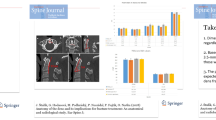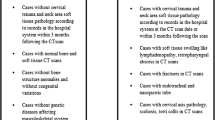Abstract
Aim
A morphometric analysis of the odontoid process of the A2 vertebra, in the Greek population, was conducted using CT scan. We aimed to determine the feasibility to use one or two screws when treating fractures of this anatomic element.
Patients and methods
One hundred and fifteen patients (57 men) of a mean age of 48 years (16–95 years) underwent a cervical spine CT scan examination. The anterior–posterior and transverse diameters of the odontoid process were measured from the base, at 1-mm interval upward on axial CT images. The length from the tip of the odontoid process to the anterior–inferior angle of the body of the axis was calculated. Data concerning the height and weight of the examined patients were collected.
Results
The mean transverse and anterior–posterior distances were found to be 11.46 and 10.45 mm, respectively, for the upper end of the odontoid process. At the neck level of the odontoid process, the equivalent mean values were 11.12 and 8.73 mm, respectively, while at the base, these distances were found to be 13.84 and 12.3 mm, respectively. The mean distance from the tip of the odontoid to its base was 17.25 and 17.28 mm, respectively, while the mean distance from the tip of the dens to the anterior–inferior corner of the axis’ body was 39.2 mm. Men showed greater values than women.
Conclusions
In this study, it was shown that in the Greek population there is enough room for one 4.5-mm or one 3.5-mm cannulated screw to be used. The application of two 3.5-mm screws is feasible in 58.6 % of the male and 26.3 % of the female population. This confirms that the knowledge of the true dimensions of the odontoid process is of paramount importance before the proper management of fractured dens using the anterior screw technique.


Similar content being viewed by others
References
Korres DS (2013) Fractures of the odontoid process. Chap 6, in the «The Axis Vertebra». Springer, Berlin
Bohler J (1982) Anterior stabilization for acute fractures and nonunions of the dens. J Bone Joint Surg Am 64:18–27
Daher Mario Tavares, Daher Sergio, Nogueira-Barbosa Murilio Henrique, Defino Helton Luiz Aparecido (2011) Computed tomographic evaluation of odontoid process: implications for anterior screw fixation of odontoid fractures in an adult population. Eur Spine J 20:1908–1914
Nucci RC, Seigal S, Merola AA, Gorup J, Mroczek KJ, Dryer J, Zipnick RI, Haher TR (1995) Computed tomographic evaluation of the normal adult odontoid. Implications for internal fixation. Spine (Phila Pa 1976) 20:264–270
Yusof MI, Yusof AH, Abdullah MS, Hussin TM (2007) Computed tomographic evaluation of the odontoid process for two-screw fixation in type-II fracture: a Malaysian perspective. J Orthop Surg (Hong Kong) 15:67–72
Korres DS, Mavrogenis AF, Gratsias PE, Lyritis G, Papagelopoulos PJ (2008) It is time to reconsider the classification of dens fractures: an anatomical approach. Eur J Orthop Surg Traumatol 18:189–195
Korres DS, Stamos KG, Andreakos AG, HArdouvelis CHR, Kouris A (1989) Fractures of the dens at risk of pseudarthrosis. Arch Orthop Trauma Surg 108:373–376
Bakirci S, Sendemir E, Kafa IM (2014) Morphometric analysis of C2 vertebra. Acta Med Mediter 30:269–272
Tun Kegan, Kaptanoglou Erkan, Cemil Berger, Mehmet Yorubulut S, Karahan Tuna, Tekdemir Imbrahim (2009) Anatomical study of axis for odontoid srew thickness, length and angle. Eur Spine J 18:271–275
Naderi S, Arman C, Guvencer M, Korkman E, Senoglu M, Telik S, Arna MN (2006) Morphometric analysis of C2 body and the odontoid process. Turk Neurosurg 16:14–18
Koulkami AG, Shah MS, Marvah RA, Hanagandi PB, Talwar IR (2015) CT based evaluation of odontoid morphology in the Indian population. Indian J Orthop 47(3):250–254
Schaffler MB, Alson MD, Heller JG, Garfin SR (1992) Morphology of the dens. A quantitative study. Spine 17:738–742
Korres DS, Karachalios T, Roidis N et al (2004) Structural properties of the axis studied in cadaveric specimens. Clin Orthop Relat Res 418:134–140
El Saghir H, Bohm H (2000) Anderson type II fracture of the odontoid process: results of anterior screw fixation. J Spinal Disord 13:527–531
McBride AD, Mukherjee DP, Kruse RN, Albright JA (1995) Anterior screw fixation of type II odontoid fractures: a biomechanical study. Spine (Phila Pa1976) 20:1855–1860
Sasso R, Doherty BJ, Crawford MJ, Heggeness MH (1993) Biomechanics of odontoid fracture fixation. Spine (Phila Pa 1976) 18:1950–1953
Doherty BJ, Heggeness MH, Esses SI (1993) A biomechanical study of odontoid fractures and fracture fixation. Spine (Phila Pa 1976) 18(2):178–184
Doherty BJ, Heggeness MH (1995) Quantitative anatomy of the second cervical vertebra. Spine 20:513–517
Funding
No funding has received for this study.
Author information
Authors and Affiliations
Corresponding author
Ethics declarations
Conflict of interest
All authors declare that they have no conflict of interest.
Ethical standards
All procedures performed in studies involving human participants were in accordance with the ethical standards of the institutional and/or national research committee and with the 1964 Helsinki declaration and with its later amendments or comparable ethical standards.
Rights and permissions
About this article
Cite this article
Korres, D.S., Lazaretos, J., Papailiou, J. et al. Morphometric analysis of the odontoid process: using computed tomography—in the Greek population. Eur J Orthop Surg Traumatol 26, 119–125 (2016). https://doi.org/10.1007/s00590-015-1717-z
Received:
Accepted:
Published:
Issue Date:
DOI: https://doi.org/10.1007/s00590-015-1717-z




